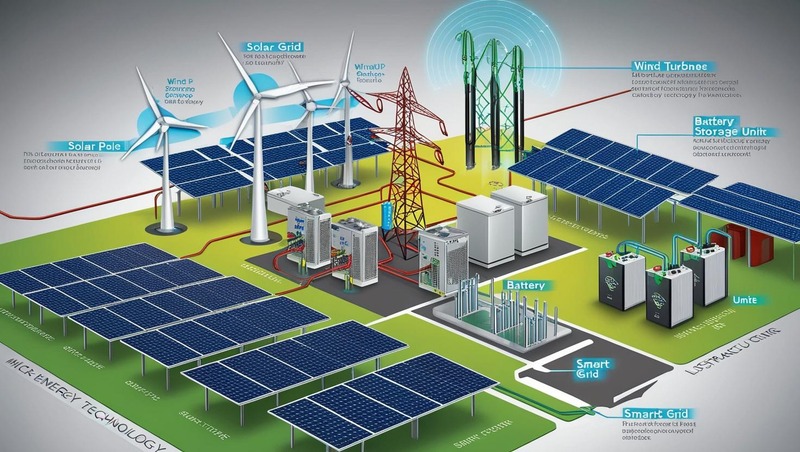As the world moves toward a more sustainable energy future, microgrids have emerged as a critical component in decentralized energy systems. Microgrids—localized energy networks capable of operating independently or in conjunction with the main power grid—offer reliability, flexibility, and efficiency. One of their most promising attributes is the integration of renewable energy sources such as solar and wind. However, the intermittent and unpredictable nature of these sources poses operational challenges. This is where Artificial Intelligence (AI) plays a transformative role, enabling microgrids to integrate renewables more efficiently, reliably, and intelligently.
AI brings advanced data analytics, predictive modeling, and real-time decision-making to the forefront of energy management. Traditional microgrid systems often struggle to manage the variability of renewables. AI algorithms, however, can analyze massive volumes of historical and real-time data—including weather forecasts, consumption patterns, and energy generation rates—to predict and optimize energy flow. By forecasting solar irradiance or wind speeds with greater accuracy, AI helps microgrids plan energy storage and distribution in advance, thus reducing reliance on fossil-fuel-based backup generators.
Download PDF Brochure @ https://www.marketsandmarkets.com/pdfdownloadNew.asp?id=917

Another significant contribution of AI is in load forecasting and demand-side management. Microgrids need to constantly balance generation with consumption to ensure stability. AI systems can predict energy demand at granular levels, enabling microgrid operators to match supply with anticipated loads more precisely. This predictive capability becomes especially valuable when integrating renewables, which fluctuate depending on environmental conditions. With AI, energy distribution can be dynamically adjusted in real-time, improving grid resilience and minimizing energy waste.
Energy storage systems are pivotal in bridging the gap between renewable supply and consumption demand. AI enhances the efficiency of battery storage by determining optimal charging and discharging cycles. Machine learning models can assess when to store excess renewable energy and when to release it, depending on usage trends and pricing signals. This intelligent battery management extends the lifespan of storage systems and reduces operational costs, making renewable integration more economically viable.
Furthermore, AI enables automated fault detection and predictive maintenance within microgrids. Renewable energy infrastructure, such as solar panels and wind turbines, is prone to wear and tear. Through AI-powered monitoring systems, microgrids can continuously assess equipment health and identify issues before they escalate. Predictive maintenance minimizes downtime, improves asset longevity, and ensures consistent energy production from renewable sources.
Decentralized energy trading is another frontier where AI adds immense value. In a network of interconnected microgrids, excess renewable energy generated in one unit can be traded or sold to another. AI platforms can facilitate peer-to-peer (P2P) energy trading by automating transactions, verifying demand-supply availability, and ensuring optimal pricing based on market conditions. This capability democratizes energy access and incentivizes renewable adoption among communities and enterprises.
Cybersecurity is also an essential consideration in AI-powered microgrids. As microgrids become more digitized and interconnected, they face increased vulnerability to cyber threats. AI-based security systems can detect anomalies, identify potential breaches, and implement countermeasures in real-time. The ability to safeguard renewable energy infrastructure from cyberattacks is crucial to maintaining operational integrity and public trust.
In addition to technical benefits, AI enhances the sustainability profile of microgrids by reducing carbon emissions and improving energy equity. By maximizing the use of clean energy and minimizing the dependence on fossil fuels, AI supports global climate goals. Moreover, AI-enabled microgrids can be deployed in remote or underserved regions, where centralized grid access is limited. This not only brings electricity to off-grid communities but also ensures that the energy delivered is green, efficient, and reliable.
The synergy between AI and renewable energy in microgrids is redefining the landscape of modern power systems. As AI technologies continue to evolve—through deep learning, neural networks, and autonomous control—the potential for even more seamless integration of renewables will expand. Policymakers, utilities, and technology providers must collaborate to develop standards, invest in AI research, and promote innovation in this space.
Frequently Asked Questions (FAQs) on the Microgrid Market
- What is a microgrid?
A microgrid is a localized energy system that can operate independently or in conjunction with the main power grid, integrating various energy sources like solar, wind, diesel generators, and batteries to provide reliable, efficient, and resilient electricity supply to specific areas or facilities. - How does a microgrid work?
Microgrids work by combining distributed energy resources, energy storage systems, and smart controllers to monitor and balance energy generation and consumption, ensuring consistent power availability, even during grid outages. - What are the main types of microgrids?
The primary types of microgrids include grid-connected microgrids that work with the main utility grid, off-grid microgrids that function independently in remote areas, and hybrid microgrids that combine both renewable and conventional power sources. - What are the key benefits of using microgrids?
Microgrids offer numerous benefits, including improved energy reliability, reduced electricity costs, enhanced resilience during power outages, better integration of renewable energy, and lower greenhouse gas emissions. - What are the major components of a microgrid?
Core components of a microgrid include distributed power generators (such as solar panels or diesel generators), energy storage systems (like batteries), a microgrid controller, smart meters, loads (end-use devices), and optional grid connections. - How is artificial intelligence (AI) used in microgrids?
AI is used in microgrids for real-time monitoring, energy forecasting, predictive maintenance, optimization of energy distribution, demand response management, and enhancing the integration of renewable sources through intelligent control systems.
See The Latest Semiconductor Reports:
Photovoltaics Market by Material (Silicon, CIGS, CdTe, Perovskite, Organic Photovoltaic, Quantum Dot), Component (Modules, Inverters, BOS), Installation Type (Ground-mounted, Building-integrated, Floating), Cell Type and Region – Global Forecast to 2030
Embodied AI Market by Product Type [Robots (Humanoid Robots, Mobile Robots, Industrial Robots, Service Robots, Cobots), Exoskeletons, Autonomous Systems, Smart Appliances], Level of Embodiment (Level 1, Level 2, Level 3) – Global Forecast to 2030
